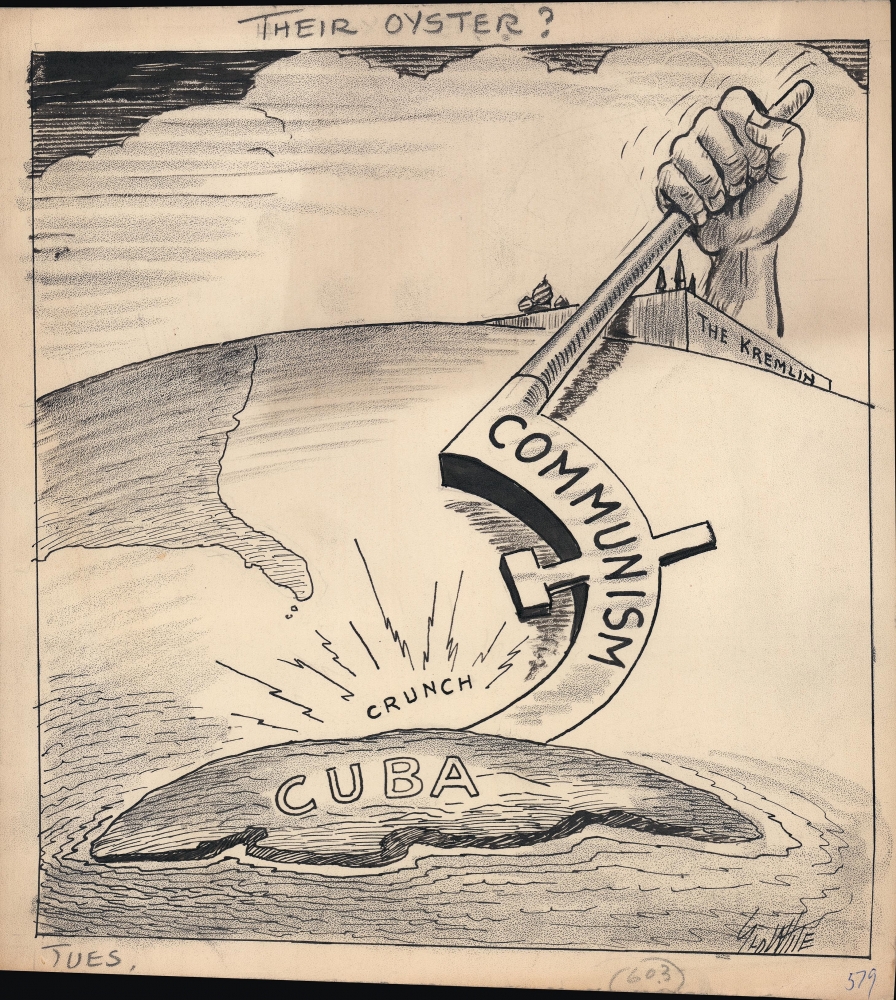1961 White Cartoon Original Art, Cuba-Soviet Relations
Cuba-white-1961
Title
1961 (undated) 11 x 10 in (27.94 x 25.4 cm)
Description
A Closer Look
The cartoon depicts the Kremlin reaching across the world to use the sickle, of the hammer and sickle symbolizing Communism, to pry open the 'oyster' of Cuba. It was most likely drawn in the fallout from the April 1961 Bay of Pigs Invasion, when Cuba turned to the Soviet Union for support and security.Historical Context
The Cuban Revolution began with a small group of guerillas around the brothers Fidel and Raúl Castro in 1953. Despite setbacks, including both brothers being arrested soon afterwards, their movement grew throughout the 1950s, drawing on anger over corruption, inequality, and oppression by the U.S.-backed military dictatorship of Fulgencio Batista. Support for the Batista government eroded in the late 1950s, including from the U.S., which imposed an embargo on Cuba, recalled its ambassador, and even reached out to build connections with the Castros' 26th of July Movement.These forces culminated in a collapse of Batista's regime on New Year's Eve, 1958, with Batista fleeing the country in the early morning hours of January 1. Up to this point, the 26 of July Movement had a generally left-wing orientation, including a growing role for the transnational Marxist revolutionary Ernesto Che Guevara, but was not closely aligned with the Soviet Union. Only in the following months, as Castro solidified power in Cuba and relations with the U.S. deteriorated, did the Soviets and Cubans develop a relationship that quickly blossomed into an alliance.
Most notably, the Bay of Pigs Invasion, a failed attempt by C.I.A.-backed anti-Castro rebels to overthrow the regime in April 1961, brought Cuba and the Soviets closer together. The Soviets came to regard the defense of Cuba as a test of resolve and feared that the Socialist world would lose respect for its leader if the Americans overthrew the Cuban regime. The Soviets were also irritated by the deployment of American ballistic missiles in Italy and Turkey, leading Khrushchev to view the secret deployment of nuclear missiles to Cuba as justified. The subsequent Cuban Missile Crisis was widely seen, even within the Socialist Bloc, as resulting from Khrushchev having overplayed his hand. Nevertheless, the Castro regime survived and remains in power today, though somewhat shakily following the collapse of the Soviet Union and the retirement of both Fidel and Raúl Castro (and the death of the former) in recent years.
Publication History and Census
This is the original manuscript draft of George White's cartoon for the Tampa Morning Tribune. It is undated, but most likely dates from 1961, probably following the failed Bay of Pigs invasion, when relations between Cuba and the Soviet Union became much closer.Cartographer
George White (1901 - March 7, 1964) was born in Grand Rapids, Michigan and relocated to Tampa with this family in 1915. White studied art under Tampa artist Walter Collins and began work as a commercial artist at the Tampa Morning Tribune in 1928 and by 1934 was a regular cartoonist at the Tribune. Rather unconventionally, the paper featured his cartoons on the front page. His work displays the evolving course of America's domestic and geopolitics from the interwar period, through the Second World War, and into the Cold War More by this mapmaker...

